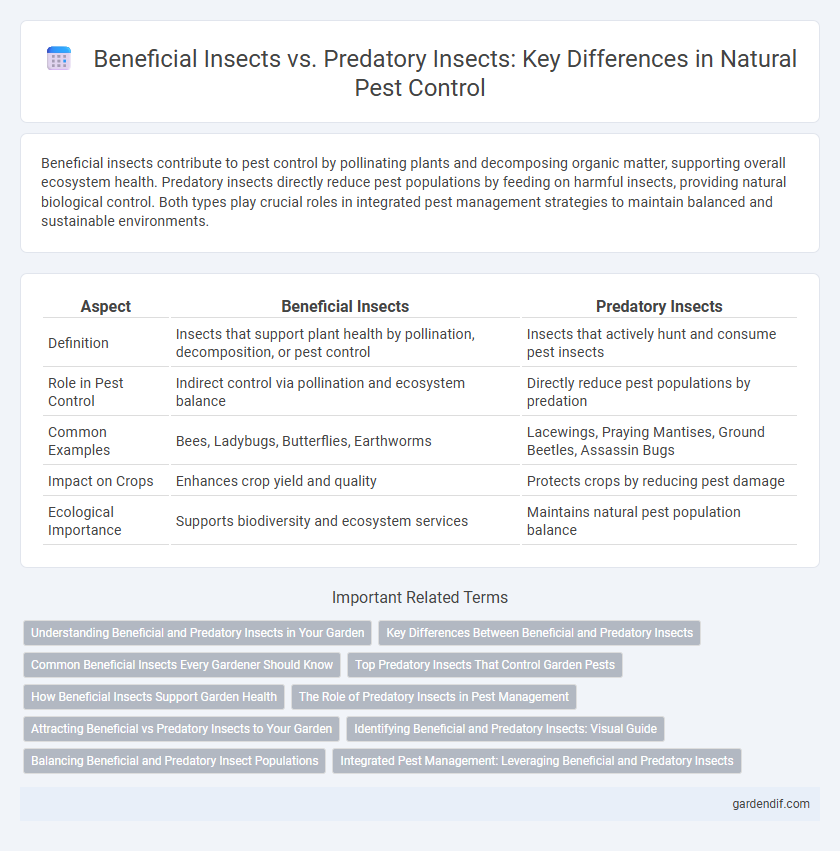
Beneficial insects vs Predatory insects Illustration
Beneficial insects contribute to pest control by pollinating plants and decomposing organic matter, supporting overall ecosystem health. Predatory insects directly reduce pest populations by feeding on harmful insects, providing natural biological control. Both types play crucial roles in integrated pest management strategies to maintain balanced and sustainable environments.
Table of Comparison
| Aspect | Beneficial Insects | Predatory Insects |
|---|---|---|
| Definition | Insects that support plant health by pollination, decomposition, or pest control | Insects that actively hunt and consume pest insects |
| Role in Pest Control | Indirect control via pollination and ecosystem balance | Directly reduce pest populations by predation |
| Common Examples | Bees, Ladybugs, Butterflies, Earthworms | Lacewings, Praying Mantises, Ground Beetles, Assassin Bugs |
| Impact on Crops | Enhances crop yield and quality | Protects crops by reducing pest damage |
| Ecological Importance | Supports biodiversity and ecosystem services | Maintains natural pest population balance |
Understanding Beneficial and Predatory Insects in Your Garden
Beneficial insects, such as bees and ladybugs, enhance garden health by pollinating plants and controlling pest populations, while predatory insects like praying mantises actively hunt and feed on harmful pests. Understanding the roles of both types helps gardeners implement effective biological control methods, reducing the need for chemical pesticides. Promoting a balanced ecosystem supports plant growth and naturally suppresses pest outbreaks.
Key Differences Between Beneficial and Predatory Insects
Beneficial insects include pollinators like bees and decomposers such as certain beetles that enhance ecosystem health, while predatory insects specifically target and consume pest species to control their populations. Beneficial insects support plant growth and soil fertility, whereas predatory insects provide direct pest suppression, reducing the need for chemical pesticides. Understanding these key differences aids in integrated pest management strategies that promote sustainable agriculture.
Common Beneficial Insects Every Gardener Should Know
Common beneficial insects every gardener should know include ladybugs, lacewings, and hoverflies, which help control pest populations by feeding on aphids, mites, and other harmful insects. Parasitic wasps also play a crucial role by laying their eggs inside pest insects, effectively reducing their numbers. Understanding the roles of these predatory insects enhances natural pest management and supports sustainable gardening practices.
Top Predatory Insects That Control Garden Pests
Top predatory insects like ladybugs, lacewings, and praying mantises play a crucial role in controlling garden pests by feeding on aphids, caterpillars, and other harmful insects. These beneficial predators help maintain ecological balance without the need for chemical pesticides, reducing damage to plants and promoting healthy growth. Incorporating these natural enemies into integrated pest management strategies enhances sustainable gardening practices and protects crop yields.
How Beneficial Insects Support Garden Health
Beneficial insects such as ladybugs and bees contribute to garden health by pollinating plants and naturally controlling pest populations through their reproductive activities and feeding habits. Unlike predatory insects, which primarily focus on hunting and consuming pest species, beneficial insects enhance soil quality and plant growth by supporting ecosystem balance and nutrient cycling. Their presence reduces the need for chemical pesticides, promoting sustainable gardening practices and healthier plant development.
The Role of Predatory Insects in Pest Management
Predatory insects play a crucial role in pest management by actively hunting and consuming harmful pest species, reducing their populations naturally. Unlike beneficial insects that may pollinate or decompose, predatory insects directly control pest outbreaks, making them essential in integrated pest management (IPM) systems. Examples such as lady beetles, lacewings, and predatory wasps effectively target aphids, caterpillars, and other crop-damaging pests, enhancing sustainable agricultural practices.
Attracting Beneficial vs Predatory Insects to Your Garden
Attracting beneficial insects like ladybugs, bees, and butterflies enhances pollination and natural pest control by feeding on aphids and other harmful pests. Predatory insects such as dragonflies and assassin bugs actively hunt and consume a variety of garden pests, offering targeted pest management. Creating diverse habitats with native plants, nectar sources, and water encourages both beneficial and predatory insect populations, promoting a balanced and healthy garden ecosystem.
Identifying Beneficial and Predatory Insects: Visual Guide
Beneficial insects such as ladybugs, lacewings, and bees are easily identifiable by their distinct colors and body shapes, with ladybugs showing bright red shells with black spots and lacewings exhibiting delicate green wings. Predatory insects like praying mantises and ground beetles have robust bodies and raptorial front legs designed for capturing prey, making them straightforward to distinguish in gardens. Visual identification guides focusing on wing shape, coloration, and behavior help gardeners accurately differentiate these insects for effective pest control.
Balancing Beneficial and Predatory Insect Populations
Balancing beneficial and predatory insect populations is essential for effective pest management in agriculture and horticulture. Beneficial insects like pollinators and decomposers support ecosystem health, while predatory insects actively reduce pest populations by feeding on harmful species. Maintaining habitat diversity and minimizing pesticide use fosters coexistence, enhancing natural pest control and promoting sustainable crop production.
Integrated Pest Management: Leveraging Beneficial and Predatory Insects
Beneficial insects such as pollinators and decomposers play a crucial role in maintaining ecosystem balance, while predatory insects actively control pest populations by feeding on harmful species. Integrated Pest Management (IPM) strategies leverage these natural allies to reduce reliance on chemical pesticides, promoting sustainable agriculture and minimizing environmental impact. Effectively combining beneficial and predatory insects enhances crop protection and supports biodiversity within agricultural systems.
Beneficial insects vs Predatory insects Infographic

 gardendif.com
gardendif.com